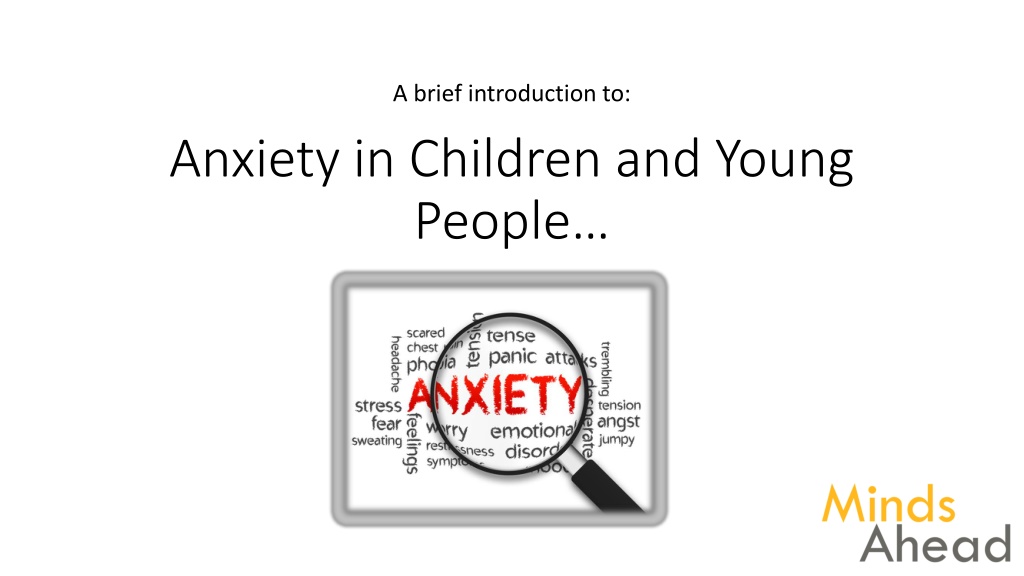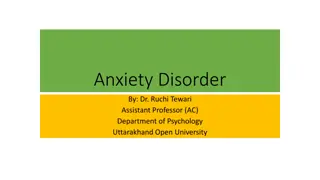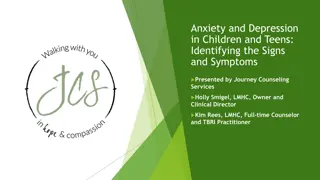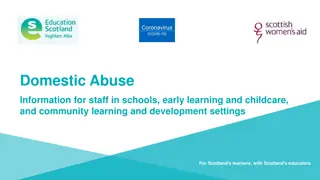Understanding Anxiety in Children and Young People
Anxiety is a common experience for children, but when it starts affecting daily life, it may indicate a disorder. Recognizing symptoms, seeking help, and understanding various anxiety disorders can help in managing and supporting children's mental health effectively.
Uploaded on Oct 01, 2024 | 0 Views
Download Presentation

Please find below an Image/Link to download the presentation.
The content on the website is provided AS IS for your information and personal use only. It may not be sold, licensed, or shared on other websites without obtaining consent from the author. Download presentation by click this link. If you encounter any issues during the download, it is possible that the publisher has removed the file from their server.
E N D
Presentation Transcript
A brief introduction to: Anxiety in Children and Young People
Anxiety Anxiety It s normal and at times even necessary for children to feel worried or anxious at times. Anxiety is a feeling of unease, such as worry or fear it's an understandable reaction in children to change or a stressful event. For some children however anxiety can effect a child s behaviour and thoughts on a daily basis. This can in turn interfere with a number of aspects of their life for example, school, relationships, accessing experiences and opportunities. Symptoms of anxiety are varied, however if they become persistent or exaggerated this may indicate a disorder.
Anxiety is one of the common mental health problems. Nearly 300 thousand young people in Britain have an anxiety disorder. Lots of people however, suffer in silence. It is important to recognise problems and seek help especially when it starts affecting your everyday life. http://www.rcpsych.ac.uk/healthadvice/parentsandyouthinfo/youngpeople/worriesandanxieties.aspx In the UK, anxiety disorders are estimated to affect 5-19% of all children and adolescents, and about 2-5% of children younger than 12. Separation anxiety is the most common anxiety disorder in children younger than 12. http://www.nhs.uk/conditions/anxiety-children/Pages/Introduction.aspx The majority of referrals to specialist services are made for difficulties and behaviours which are more immediately apparent and more disruptive (externalising), however there are increasing concerns about the problems facing more withdrawn and anxious children, given the likelihood of poorer outcomes. Mental Health and behaviour in schools: DFE March 2016
Types of Anxiety Disorders Types of Anxiety Disorders Separation Anxiety Disorder Phobias Social Anxiety Generalised Anxiety Order Panic Disorders Obsessive Compulsive disorders
What causes anxiety disorders? What causes anxiety disorders? Past or childhood experiences Every day habits and events Diet Physical and Mental health Drugs or medication Genetics
Activity Activity Think of a situation in which you have felt, or are likely to feel anxious. Situation/ Event (where, what, who, when) Thoughts Behaviour Emotions Physical
Common symptoms of anxiety Common symptoms of anxiety Thoughts Emotions Something awful will happen I cant do this What if I fail How will people view me Its not going to work Embarrassed/ tearful Scared/ panicky Nervous/ Fidgety Irritable Fearful Physical Symptoms Increased heart rate Behaviours Avoidance Under/ over eating Physical tension/ headaches/ feeling sick hot/ sweaty Breathless/ Feeling faint Difficulty sleeping Increased unhealthy crutches (smoking/ drinking) Arguing/ withdrawing Talking faster
Ways I manage anxiety Ways I manage anxiety Thoughts Emotions Anxious Scared Nervous Irritable Fearful Something awful will happen I cant do this What if I fail How will people view me Physical Symptoms Increased heart rate Physical tension/ headaches hot/ sweaty Feeling faint Insomnia Behaviours
Impact of anxiety on children and young people Impact of anxiety on children and young people and their future outcomes and their future outcomes Greater difficulty learning Undermines educational attainment Relationships Missing school Exclusion Poorer social and economic outcomes in later life
Whole school Approaches Whole school Approaches PSHE programmes i.e. SEAL CIRCLE TIME Classroom management/ Environment SPECIAL PROJECTS/ Events Peer Massage Mindfulness Working with parents/ carers Working with partner agencies
Targeted Programmes Targeted Programmes One to one group work (CAS) Relaxation/ visualisations/ mindfulness Creative Therapeutic approaches CBT Emotional Literacy/ Resilience programmes Restorative programmes
Case Study: Mollie Year 6 Case Study: Mollie Year 6 Mollie presents in school, as an extremely quiet, anxious little girl, always responding appropriately to adult requests but very rarely if ever actively involved in class. At times Mollie can appear over concerned about pleasing others (to the detriment of herself) and very defeatist in her attitude. Mollie can appear anxious and is regularly known to be unable to assert herself at times when this has been essential. For example, recently she was invited to Art club. This was something she did want to attend, however upon arrival at the classroom it appeared she went into freeze mode, hovering at the door, refusing to come in, unable to say why, resulting in a tearful breakdown. On this occasion she went home and mum reported how she dwelled on this for a prolonged period, suggesting she should come back to school. The next day Mollie presented to me first thing to apologise for her behaviour. This was completely unnecessary and was relayed back how staff were worried for how distressed she had become. When situations have occurred in the day, which for the over whelming majority of children would be forgotten as soon as they leave the school gates, Mollie continues to worry about this. Educationally Mollie has made progress this year however had a meltdown in the tests before Christmas, resulting in her becoming tearful and physically sick. Mollie has been exposed to emotional harm, via comments made by her Dad with reference to the separation of her parents. Mollie has been called hurtful names ( xxxx snake ) and despite mums protests and encouragement to ignore this (and has recently stopped contact), appears to have possibly internalised this, writing letters (which have been found) which suggest she blames herself for this adults behaviour. It would appear she wants to please others to the detriment of helping herself. She has also been exposed to comments such as well it was your brother I wanted and appears (without surprise) to have had a real impact on her self esteem/ self worth. It would appear from comments Mollie has made to mum that she feels a sense of rejection from her Dad and has attempted to express this through the creation of lists incorporating good and bad aspects of her relationships with others. Mollie is a gentle little girl, sensitive to others, specifically her mum. More recently it would appear she is becoming more sensitive resulting in emotional distress. She is unable at this time to explain what has happened and would appear to catastrophize the situation. She has made reference to not wanting to cry in front of her mum (other adults), but yet being there for her mum at times when she has been upset. Mollies mum in the past has approached school with concerns related to Mollies behaviours to which she labelled OCD. When this was explored further it would appear Mollie is a very tidy little girl, who does like order, however does not get distressed if things are not in place. Mollies mum was also able to reflect on her own tidy , ordered behaviours and how at times cleaning etc. has been used as a coping strategy. It was discussed that Mollie could be emulating these behaviours. Mum has recently reported being diagnosed as having PTSD. Mum has reported physical aggression in the past between both herself and Mollies Dad, however it would appear from comments made, Dad may have also been emotionally abusive to Mum which is likely to have been observed by Mollie. Mollie has an older sister (15) and a younger brother (5). Mollies sister has been excluded from school.
Case Study: Mollie Year 6 Case Study: Mollie Year 6 What are the worries? What are the strengths? What needs to happen/ who needs to be involved? Consider both whole school approaches and bespoke programmes
Activity: Facing your Fears Activity: Facing your Fears Most Feared Attending school (100%) Visiting school (90%) Being amongst school peers (80%) Being amongst strangers (70%) Time with friends out of the home (60%) Time with friends at home : 50% Least Feared
Ive come to a frightening conclusion that I am the decisive element in the classroom. It s my personal approach that creates the climate. It s my daily mood that makes the weather. As a teacher, I possess a tremendous power to make a child s life miserable or joyous. I can be a tool of torture or an instrument of inspiration. I can humiliate or heal. In all situations, it is my response that decides whether a crisis will be escalated or de-escalated and a child humanized or dehumanized. Haim G. Ginott
Thankyou Thankyou Enjoy the rest of your day .























